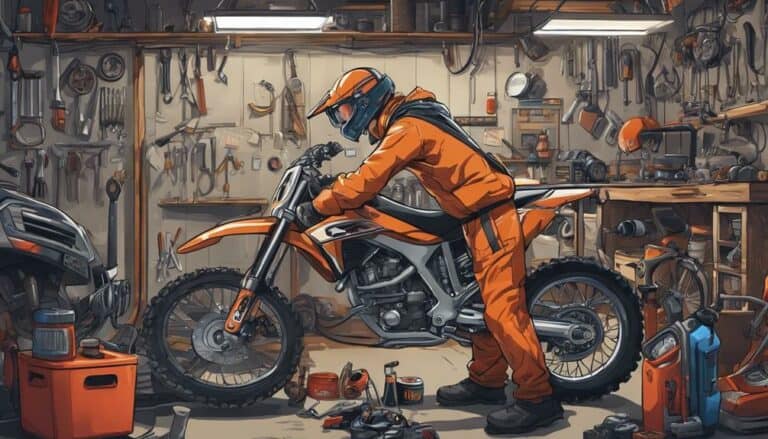When changing the oil on a 4-stroke dirt bike, you might be wondering if there's more to ponder than just the oil itself. The question of whether a new oil filter is needed can play an important role in the health of your bike's engine.
But how do you know if it's time to replace the filter, and what impact can it have on your bike's performance? Let's explore this further to make sure your dirt bike is running at its best.
Key Takeaways
- Using the right oil filter is crucial for proper engine longevity and performance.
- Choose a filter compatible with your bike's make/model for efficient filtration.
- Regularly inspect and change the oil filter to prevent blockages and maintain engine health.
- Signs of a clogged filter include low oil pressure, engine overheating, and metallic sounds.
Importance of Using the Right Filter
Using the correct oil filter for your 4-stroke dirt bike is essential for ensuring proper filtration of contaminants and protecting the engine's longevity. An oil filter plays a critical role in maintaining oil cleanliness by trapping harmful particles that could otherwise circulate in the engine, causing wear and potential damage. A high-quality oil filter, designed to meet the specific performance requirements of your dirt bike engine, is vital for peak filtration efficiency.
Neglecting to use the right oil filter can result in poor oil flow, reduced lubrication, and ultimately lead to engine malfunctions. OEM filters are engineered to fit your bike perfectly, ensuring proper oil filtration and flow. Regularly changing the oil filter, along with the oil itself, is paramount for sustaining peak engine performance and maximizing its lifespan.
Choosing the Correct Oil Filter
To guarantee high-quality performance and longevity of your 4-stroke dirt bike engine, selecting the appropriate oil filter is essential. When choosing the correct oil filter for your bike, consider factors such as compatibility with your dirt bike's make and model.
You have the option of selecting OEM filters for a precise fit tailored to your bike or aftermarket filters for more cost-effective alternatives. It's important to look for oil filters made from high-quality materials like metal or synthetic media, as these materials offer efficient filtration to keep your engine running smoothly.
Additionally, checking the filter's micron rating is important to ensure it can capture smaller particles and provide excellent engine protection. Verify the oil filter's flow rate as well, as this will guarantee proper oil circulation throughout your bike's engine, helping to maintain its overall health and performance.
Make sure to choose wisely to keep your dirt bike running at its best.
How to Change the Oil Filter
How can you guarantee efficient oil filtration and peak engine performance when changing the oil filter on your 4-stroke dirt bike?
To ensure best filtration and engine health, begin by inspecting the oil filter for any debris or metal particles that could signal underlying engine problems. Thoroughly clean the oil filter housing to maintain proper filtration efficiency. It's important to replace any worn or damaged seals on the oil filter housing to prevent potential oil leaks that could lead to engine damage.
When selecting an oil filter, you have the option of choosing between reusable metal filters that require cleaning or disposable paper filters that need replacement. Whichever type you choose, make sure that it fits your dirt bike's specifications for top performance.
After replacing or cleaning the filter, reassemble the oil filter housing securely to maintain the proper oil flow and filtration throughout your dirt bike's engine. Following these steps diligently will help keep your dirt bike running smoothly and efficiently.
Signs of a Clogged Oil Filter
A clogged oil filter compromises engine performance and reliability, necessitating prompt attention to avert potential damage. It's a good idea to be vigilant for signs indicating a blocked oil filter. Keep an eye out for low oil pressure, engine overheating, or metallic sounds emanating from the engine. These symptoms could indicate restricted oil flow due to a clogged filter.
During routine oil changes, take a moment to inspect the oil filter for any blockages or debris. Regularly replacing the oil filter as part of your maintenance routine is essential to prevent issues related to oil flow. Opt for a quality oil filter designed for your dirt bike's engine to ensure top-notch performance and longevity.
Tips for Maintaining Oil Filter Health
Maintaining the health of your oil filter requires regular inspection for debris, metal shavings, and dirt during oil changes to guarantee top engine performance. When inspecting, make sure the oil filter housing isn't only clean but also free from any damage to the seals, as this prevents oil leaks and maintains a tight seal.
Choosing between reusable metal oil filters or disposable paper filters is a personal preference, but it's important to select based on your maintenance schedule. After cleaning or replacing the oil filter, reassemble the housing securely to prevent oil leaks and ensure proper filtration of contaminants.
Conclusion
To sum up, always remember: 'An ounce of prevention is worth a pound of cure.'
Proper maintenance of your 4-stroke dirt bike's oil filter is essential for the smooth operation and longevity of your engine. By choosing the correct filter, regularly inspecting for damage or clogs, and replacing as needed, you can secure top performance and protect your investment in your bike.
Stay proactive in your maintenance routine to avoid costly repairs down the road.

